Inside the surreal world of Andrew Baines
As high-profile Adelaide artist Andrew Baines prepares to show his latest work in a new solo show titled The Search for Sanity, he reveals to Samela Harris some of the underlying things that drive the engine of his art.

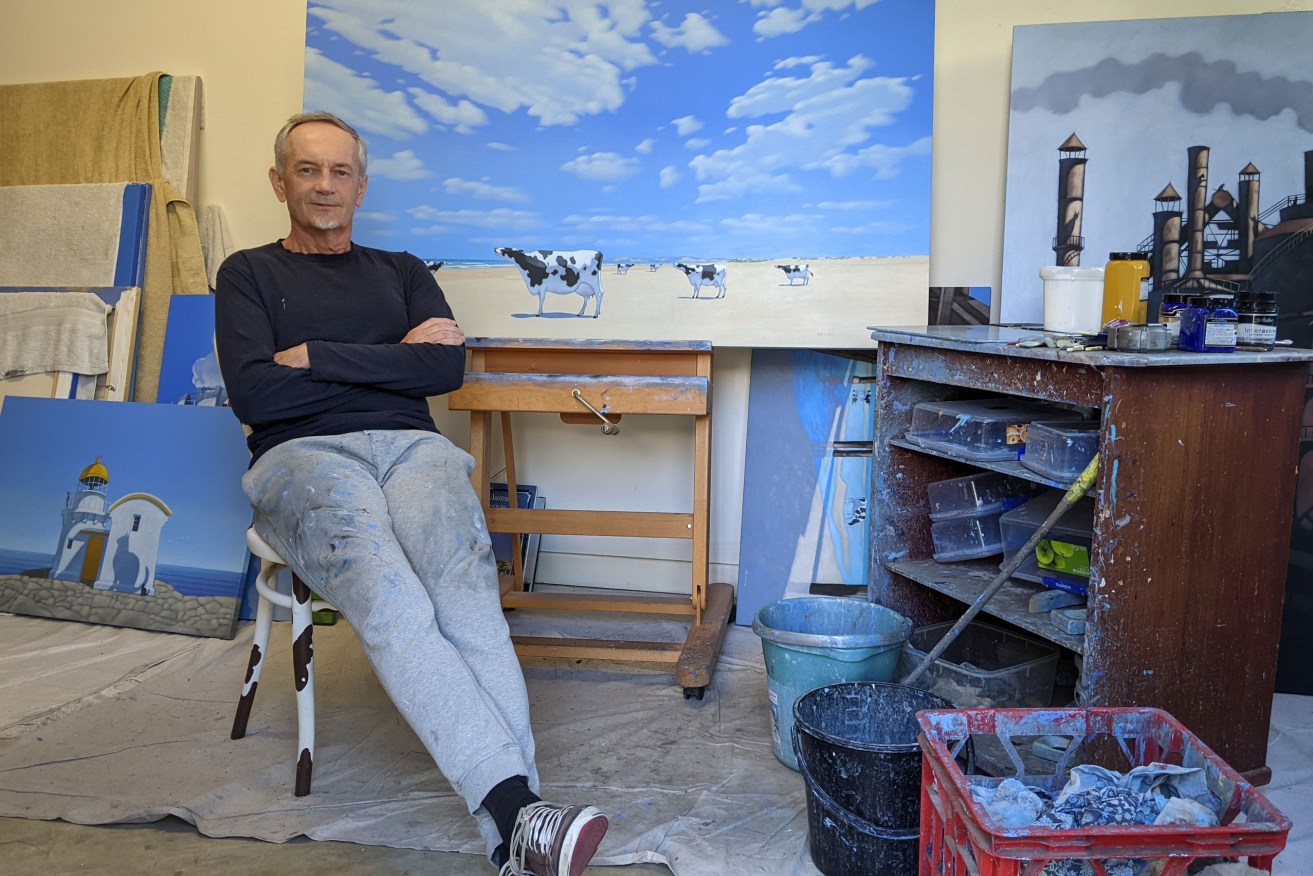
Andrew Baines in his Grange studio, with one of his famous paintings of cows on the beach sitting on the easel behind him. Photo: Carolyn Wade
The Covid lockdown knocked people around in myriad ways, but for Andrew Baines, its cruel blow was that the city’s art suppliers suddenly ran out of his hallmark blue acrylic paint.
“I felt as if my throat had been cut,” he declares, still reeling at the unexpectedness of it all.
Just as people rushed out and bought dogs during the lockdown, many of them picked up paintbrushes and tried their hand at hobby art, unwittingly stressing supplies.
Without his beloved Matisse Ultramarine blue, Adelaide’s wildly imaginative exponent of the blue-sky, blue-sea scene could not go on with his commissions and gallery-exhibition paintings.
He tried, but a substitute blue was not “his” blue. So, in the acrylic blue drought, the prolific painter just stopped painting.
“I had to turn to drawing and thinking of new ideas,” he says.
Some dealers had been suggesting they would like to see a change from his bowler-hatted and besuited men and the cows in the sea, so his brain was already stirring.
Baines describes his mind as a whirling pot of wild ideas at the quietest of times. He wonders if its hyperactivity is a kind of madness. He knows other people don’t think the way he does. There’s a self-love, self-hate dichotomy in play. His creative agitation both powers him and troubles him. He’s dubbed his latest show The Search for Sanity.
“I’m not sure if I’m creative or suffer from delirium,” ponders the surrealist painter.
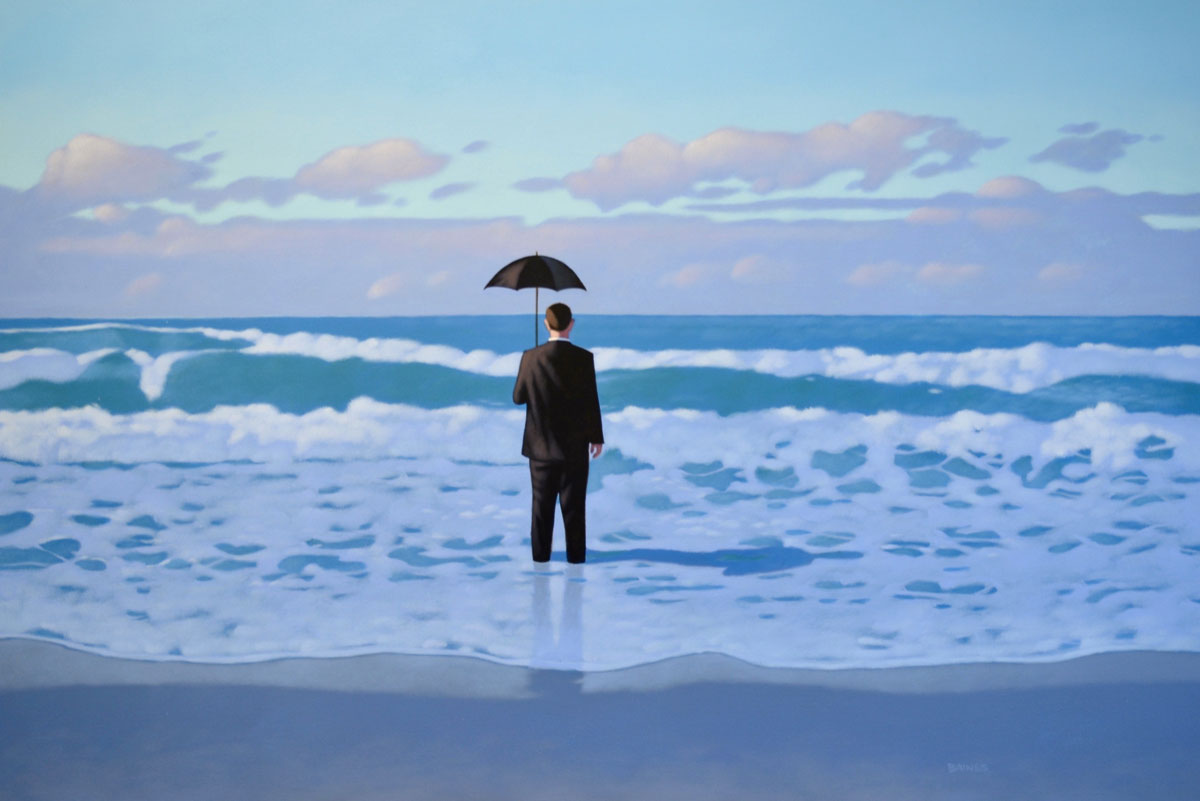
The Search for Sanity, by Andrew Baines.
Baines is a lean, angular man, handsome with his neat Van Dyke beard.
His Grange studio is in a converted backyard workshop, just a short stroll from his favourite haunt, Joe’s Cafe. Its air is rich with the scent of paint. Cleaned brushes are neatly set out drying on a cabinet beside a painting-in-progress which itself is drying on an easel. There’s a hair-dryer on the floor. Well-used paint cloths also lie on the floor, which is protected with elderly tarpaulins. Buckets contain coloured water – blue, of course. Canvases of various sizes are stacked against the walls. He is preparing for an imminent one-man show at BMGArt.
Baines’ creative output does not stop at painting. He is a man driven. He writes. He makes movies when he can. He networks with the media and keeps a high profile on social media. He has written and published his own pocket art book, Museum of My Mind, complete with “quotes to help you escape reality”. The droll quotes are Baines-style titles for paintings, quirkily brilliant in their way: Don’t believe everything you think; What if your reality is actually an illusion?; I took the road less travelled and got bogged; I have fully succeeded in not being able to find myself; Imagination can see what our eyes can’t.
Now, out of the blue, so to speak, the entrepreneurial “quasi surrealist” painter has emerged with a new period. As Picasso had a blue period, the blue-loving Baines now has a cat period to add to his cow period and his bowler-hatted period. He paints cats casting their shadows on island beacons. Sometimes there’s a lost soul standing there with a cat; sometimes there’s a bicycle which can go nowhere. The more he plays with the theme, the more arresting and puzzling the images become.
“Cats and dogs!” he says.
“They know exactly what’s going on out there but people treat them like idiots. They’re a metaphor.”
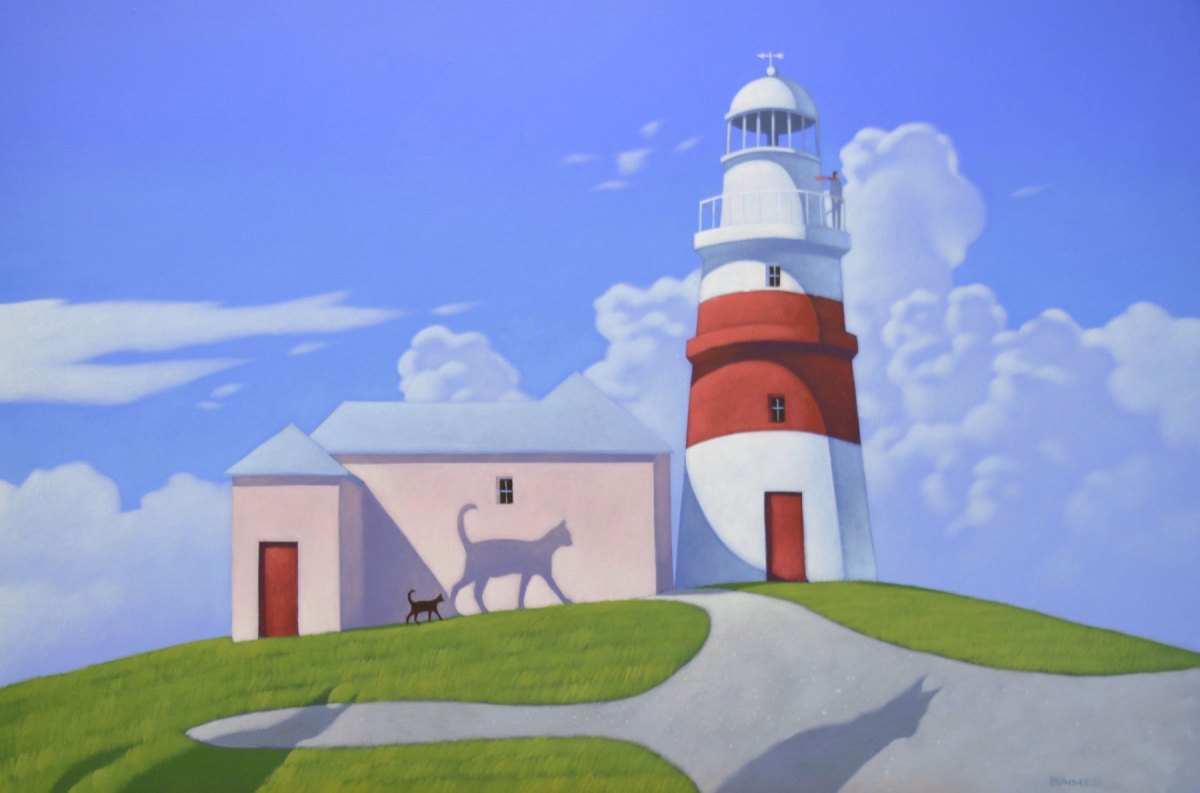
It’s raining cats: I realised nobody’s coming to save me, by Andrew Baines.
Baines has been painting beach scenes for decades. He did, after all, grow up on sublimely beautiful strands: Grange Beach with its light blue hues of shallows between sandbars grading out to vivid marine blue depths, horizon etched against an uplifting Australian sky blue.
In the early days, the young Baines painted lyrical bathing belles on the beach. Ironically, this is a subject he is revisiting. Now they are flying belles, magnificent, lithe diving creatures, caught mid-air.
The American reproduction market has been a huge boon. It can’t get enough of our Baines. “Digital prints,” he exclaims. “They pay royalties.”
While he is happy to get his head around specific commissions, he is also driven by an internal muse who, more often than not and whether she likes it or not, is his wife Jacqueline. In a strange way, Baines’ canvases are his counsel.
And amid the surrealist seascapes stacked against the wall in his studio, there’s a big, dark work showing a massive machine image of such intense complexity that the eye can’t stop reaching into its twisting detail. He jokes that it is a “portrait of his marriage”.
He entitles paintings with quips such as: “She prayed that he’d never come back but he always did.” It’s a wickedly droll wit which gives pause for thought.
All his paintings, he says, are autobiographical in one way or another – commentaries on life and love, on his own sense of self.
Baines is one of those rare painters who has found success in their own lifetime, and it is not as simple as one may think. He has been able to buy a dream home which can make him feel a bit grand at the end of a working day, a home that he feels he has been able to give to his wife as a statement of success. He says that while she loves the big house, the ever-increasing demands of success are another story.
“She sort of misses our lives as they were before,” he laments. “Simple.”
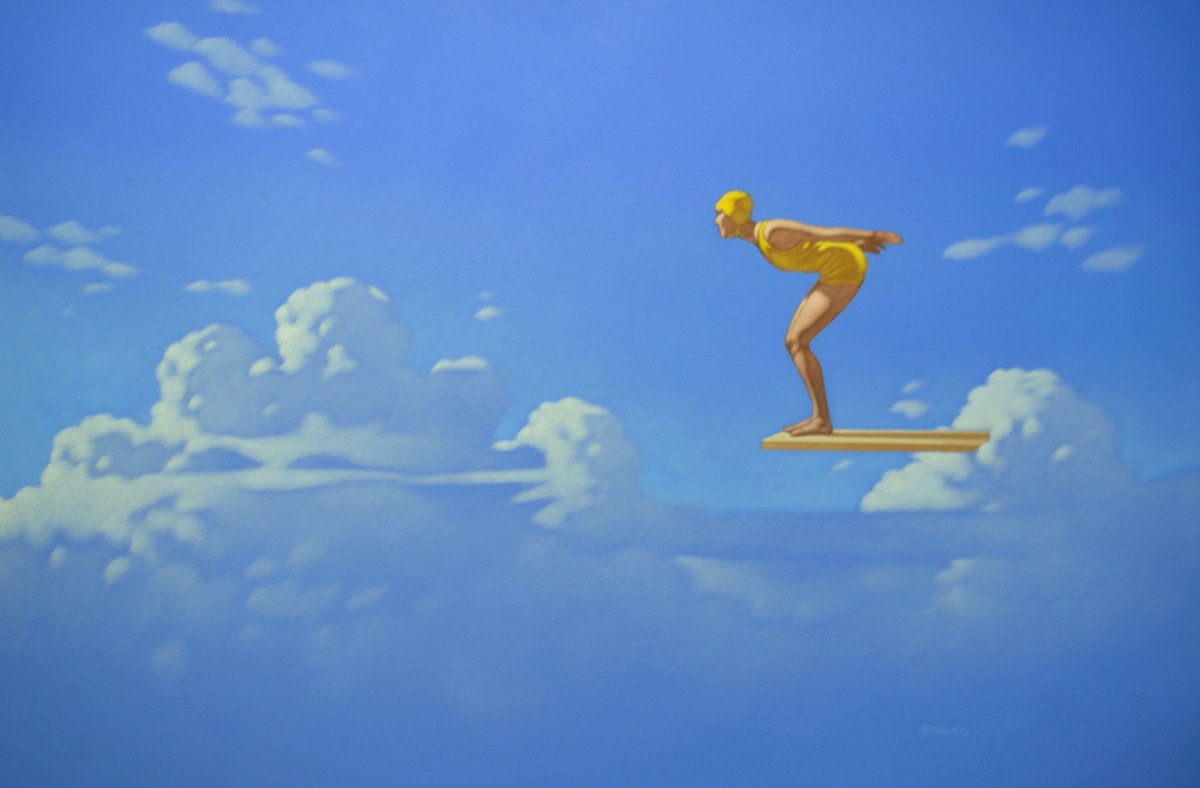
She waited long enough… one of Andrew Baines’ flying belles.
Joe, of Joe’s Café, tutored Baines in how to act whenever chauffeured politicians arrived at the magical seaside cafe for morning coffee. “He told me to watch, to smile and to laugh, but to say nothing.”
The strategy worked. The VIPs liked the deferential seaside artist who hung out at Joe’s. They liked his art. They made commissions.
Now, everyone who is anyone, it seems, wants Baines to paint their portraits.
His favourite commission to date was from John Dawkins, the former Liberal MLC. Dawkins commissioned a portrait which now hangs in Parliament House. Baines is agog that he, “a working-class boy”, has a place in the hallowed halls of Parliament. Since his subject was a man of the country, a sheep farmer from Gawler, Baines gave him sheep and wheat fields as a background, delivering a portrait decidedly unlike the traditionalist canvases which bedeck those hallowed halls; as he puts it with unrestrained pleasure, it “stands out like dogs’ balls”.
If Baines summons, they will come. That is how he achieved his huge and quite bizarre beach installations: the bourgeois professionals en masse, all dressed in black, all getting wet and standing patiently in the shallows as he lines them up and takes photographs; Alexander Downer on the beach inside a red door frame; politicians on lavatories; judges confronting un-judgeable vast horizons of the sea; London’s bowler-hatted tube travellers in the Antipodean sunshine; besuited businessmen in the frothy shallows; and musicians way out of their comfort zones.
If he calls for short dogs, they arrive in hordes. Baines loves dogs, especially sausage dogs. He paints dog towers: dogs on top of dogs on top of dogs.
Then there are his unheard-of herds of cows. From studies of cows beneath jetties and cows in the shallows, he has given the bovine a political voice. Cows on beaches with their necks extended and their lips pursed are “conspiracy cows”. They are satirical cows, a silent bellow at the mayhem of fake news and dangerous conspiracy theories.
The more you put out there, the more things happen
Baines has always been a ferocious self-promoter, and his offbeat installations make for brilliant light relief in the dour world of the daily news cycle. The media is guaranteed to pay attention. And publicity means sales and commissions.
But, of course, there remains the art establishment and the caustic eye of the serious art critics – another flea in the ear of this complex painter.
Leading art critic Sasha Grishin, writing in The Canberra Times, said Baines’ bowler-hatted men did not have the “haunting enigma” characteristic of the great Belgian surrealist René Magritte. He wrote that Baines’ paintings “are easy on the eye and not too taxing on the brain” and “light-hearted vignettes of absurdist ideas”.
Baines was cut to the core by this. But he has to acknowledge, however grudgingly, that he is not the first artist in the world to be rebuffed by “the old guard”. People love him nonetheless. His paintings please them. And as the works meet the art auction rooms, prices are up.
No, he is not Magritte. He is Andrew Baines, an accomplished draftsman whose works are not only arresting to the eye and provocative to the mind, but also very fastidiously fashioned with offbeat ideas imposed upon backgrounds of impeccable geometric precision.
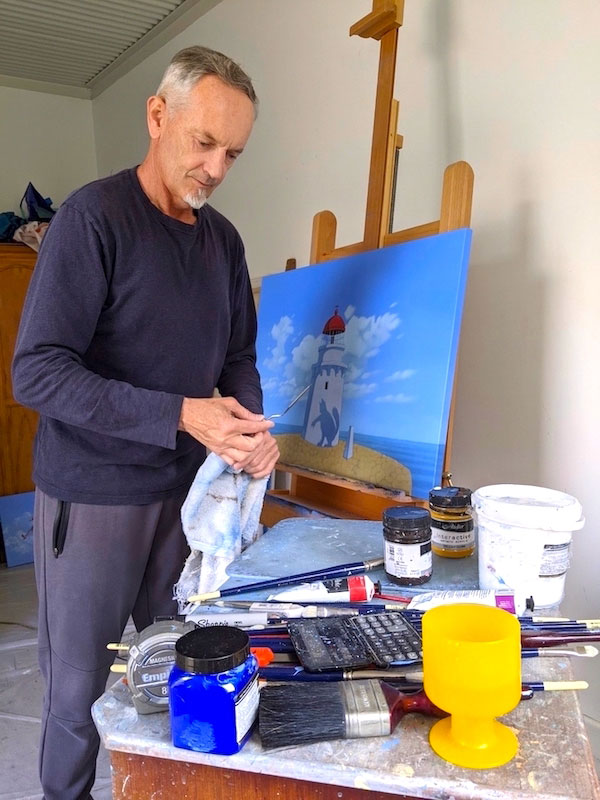
Andrew Baines has found the life he wanted. Photo: Carolyn Wade
Baines says Andy Warhol, David Hockney, Ken Done, Pro Hart and Jeffrey Smart are the artists he has always most admired.
“I saw in them a life I wanted,” he says. He found it. Now he drives a Mercedes convertible.
This, from the electrician’s son born in Colchester, Essex. Baines, with his parents and brothers, migrated to Adelaide to begin a new life at Grange, whence Baines has barely moved ever since. It is his sacred place with the sea his muse and dear old Joe’s Cafe, now adorned with Baines’ murals and model dachshunds on the roof, his famous coffee spot.
He went to school down the road at Grange Primary and up the road at Seaton High. Painting was always the big thing for Baines from a wee age; he went on to classes at Henley and Grange Art Society aged 10 and never really looked back. A sojourn at the SA School of Art was useful but it interrupted his early employment as a commercial artist doing backdrops and window displays at John Martins, including the Magic Cave.
By 1983, he had started his own Baines Graphic Arts company and was getting work from the F1 Grand Prix, BP Australia and the Soccer Federation, as well as doing cartoons and murals. Not that he stopped painting. By 1999, Jaqueline told him it was time he throw in the towel with the day job and pursue his real dream – and so it came to pass that Andrew Baines commenced his extraordinary trajectory as a professional painter.
Now, as he gazes at the sea, he again ponders his place in the world: “I didn’t think people knew about me or cared… The mystery of life. I love the mystery of life.”
He talks of the emotional scars he carries on behalf of his late mother; a mum of three and housewife who loved to paint.
But, he declares, he really loves his widowed father. “Dad is now 84 and lives at Grange in a unit. He sits there watching TV surrounded by three portraits I’ve painted of him as entries into the Doug Moran Prize. Dad doesn’t realise that he is living in a memorial to himself.”
Baines is represented by a number of top galleries and has paintings in collections all over the country and overseas, but has yet to be displayed at the Art Gallery of SA. He has entered and been a finalist in numerous prestigious art prizes, yet still waiting to crack a big one. Another portrait of his dad is doubtless due.
Meanwhile, he has been appointed an art advisor to the UN and is working on a Harmony Day concept about the micro-plastics in the ocean. He has committed himself to two charities a year and takes charity work very seriously indeed. He is keen to support anything which helps the homeless, dreaming up a concept of city statues of homeless trolley women complete with QR codes telling their stories.
“I believe in karma,” he says. “If I help people, good things happen to me. The more you put out there, the more things happen.”
In his studio, Baines powers from canvas to canvas, each artwork carefully sketched and measured, as neat and precise as the man himself. He is diligent because he is ambitious. There is always more market, more audience, more publicity, and more acceptance.
And, whatever the critics and dealers may say about making changes, too bad. That ubiquitous old bowler hat on the pristine Adelaide beach is not going away.
“They are my trademark,” he says. “If people still want them…”
He laughs. Perchance, all the way to the bank.
Andrew Baines’ new solo exhibition, The Search for Sanity, will be at BMGArt from July 15 until August 6.




